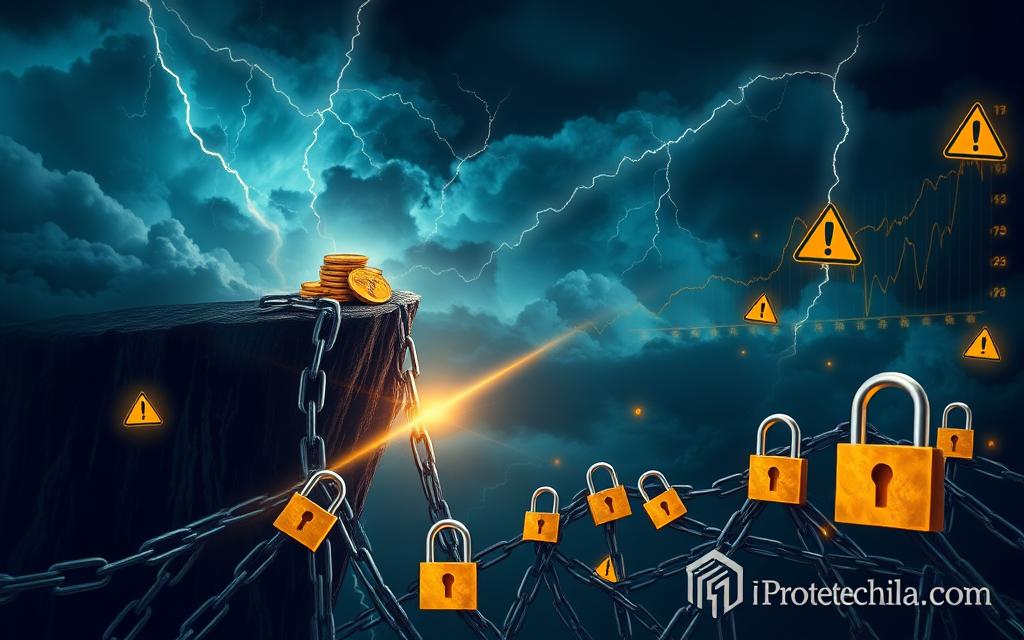In the rapidly evolving world of digital finance, cryptocurrencies have captured the attention of investors and businesses alike. These innovative digital assets promise decentralization, transparency, and new investment opportunities. However, they also come with inherent risks that must be carefully considered. This article will provide a comprehensive overview of the various crypto risks, their impact, and strategies to mitigate them. It aims to empower readers to make informed decisions in the dynamic cryptocurrency market.
Cryptocurrencies, such as Bitcoin and Ethereum, have gained significant traction in recent years. Their popularity and adoption are steadily increasing. However, the very features that make cryptocurrencies appealing, such as their decentralized nature and lack of government oversight, also introduce a unique set of risks. Investors and businesses must navigate these risks, including volatility, security concerns, and regulatory challenges. Understanding these various crypto risks is crucial for anyone seeking to participate in this emerging financial landscape.
By the end of this article, readers will have a clearer understanding of the potential pitfalls of cryptocurrency investments. They will be better equipped to make informed decisions in the digital asset market. Whether you are an individual investor or a business exploring the opportunities presented by cryptocurrencies, this comprehensive guide will provide you with the knowledge and insights needed to navigate the complex world of crypto risks.
Crypto Risks: A Comprehensive Overview
Investing in cryptocurrencies can be both thrilling and potentially lucrative. However, it comes with unique risks. It’s crucial to understand the types of crypto risks and their impact on investors and businesses. This knowledge helps in making informed decisions and protecting your assets.
Types of Crypto Risks
One major risk is the inherent volatility of cryptocurrencies. Their value can swing dramatically, exposing investors to sudden price changes. The crypto market is also vulnerable to security breaches. Hacks and thefts pose a significant threat to both individual and institutional investors.
Another concern is the rise of cryptocurrency scams. Fraudsters employ sophisticated tactics to deceive victims, from phishing schemes to fake initial coin offerings (ICOs). These crypto risks for investors can lead to substantial financial losses.
Impact on Investors and Businesses
The crypto risks for businesses in the digital asset space are substantial. Regulatory uncertainty and evolving compliance requirements pose operational challenges. The threat of cyber-attacks can disrupt business continuity and erode consumer trust.
The crypto risk impact extends far, affecting both individual investors and businesses. Effective risk management and a deep understanding of the crypto landscape are vital. They are essential for navigating this dynamic and rapidly evolving market.
“Cryptocurrency investments are not for the faint of heart. Navigating the risks requires a keen understanding of the market and a well-thought-out strategy.”
Volatility: The Double-Edged Sword of Crypto
Cryptocurrency markets are known for their high volatility, a trait that poses both opportunities and risks for investors. This volatility stems from various factors. Developing strategies to manage these risks is essential for navigating the ever-changing crypto landscape.
Factors Influencing Crypto Volatility
Price fluctuations in the crypto market are caused by several factors. These include market sentiment, regulatory changes, and supply and demand dynamics. Shifts in investor confidence, news events, and economic conditions also play a role. These elements contribute to the inherent crypto volatility seen in digital assets.
Strategies to Mitigate Volatility Risks
To tackle the challenges of crypto volatility, investors and businesses can use several strategies. Diversification helps spread risk across different digital assets and asset classes. Effective risk management practices, like setting stop-loss orders and disciplined trading strategies, are also crucial. Adopting a long-term investment horizon can help investors ride out short-term price swings and benefit from the cryptocurrency ecosystem’s potential.
| Strategy | Description |
|---|---|
| Diversification | Investing in a variety of digital assets and asset classes to spread out risk. |
| Risk Management | Implementing practices like stop-loss orders and disciplined trading strategies to manage volatility risks. |
| Long-term Investing | Adopting a patient, long-term investment horizon to weather short-term price fluctuations. |
By grasping the factors influencing crypto volatility and applying effective strategies to mitigate volatility risks, investors and businesses can confidently navigate the dynamic crypto landscape.
Crypto Scams and Hacks: Protecting Your Assets
In the world of cryptocurrencies, investors and businesses face a constant battle against scams and hacks. Cybercriminals have become more sophisticated, using advanced techniques to exploit vulnerabilities. It’s more important than ever to protect your digital assets.
The “rug pull” scam is particularly alarming. It involves developers abandoning a project, and taking all invested funds. These scams target investors looking for high returns. It’s crucial to stay informed and research projects thoroughly before investing.
| Crypto Scam | Description | Impact |
|---|---|---|
| Rug Pull | Developers abandon a new project, taking all the invested funds. | Devastating losses for investors. |
| Phishing Attacks | Cybercriminals trick users into revealing their login credentials. | Compromised accounts and stolen crypto assets. |
| Exchange Hacks | Cybercriminals breach the security of crypto exchanges, stealing funds. | Massive financial losses for exchange users. |
Phishing attacks are another common tactic. Cybercriminals trick users into revealing sensitive information. It’s vital to verify the legitimacy of any communication or website before sharing sensitive data.
Crypto exchanges have also been hacked, leading to significant losses. Using strong security measures like two-factor authentication and cold wallets can help protect against these risks.
Protecting your crypto assets requires a proactive approach. Stay informed, implement comprehensive security measures, and be cautious with new projects. This way, you can effectively safeguard your crypto assets from crypto scams and crypto hacks.
Also read: Discover the Best Cryptocurrency Exchange in the UK
Regulatory Challenges and Crypto Risks
The regulatory landscape for cryptocurrencies is constantly changing, posing risks for investors and businesses. It’s essential to stay updated on laws and regulations to manage these risks effectively. This knowledge helps in navigating the crypto market safely.
Evolving Regulatory Landscape
Worldwide, governments and financial bodies are adopting various approaches to crypto regulations. This leads to a dynamic regulatory environment. Participants in the crypto ecosystem face challenges due to the complexity of rules. These rules vary significantly across different jurisdictions.
Compliance Considerations for Businesses
For businesses in the crypto compliance for businesses sector, adhering to crypto regulations is critical. They must keep abreast of evolving crypto regulations and implement effective compliance strategies. This is to avoid legal and financial repercussions. Non-compliance can lead to severe consequences, including fines, legal battles, and even business shutdowns.
Understanding and adapting to the evolving crypto regulations landscape is crucial. Businesses need to be diligent and flexible, grasping the regulatory framework of their markets. By focusing on crypto compliance for businesses, companies can reduce risks. This positions them for success in the rapidly changing cryptocurrency industry.
Securing Your Crypto: Best Practices
Protecting your cryptocurrency is crucial in today’s digital world. It’s vital to use strong crypto wallet security and follow strict crypto key management rules. By understanding and avoiding crypto risks, you can feel more secure in the cryptocurrency market.
Wallet Security and Key Management
Choosing the right digital wallet is key to securing your crypto. Hardware wallets, which keep your private keys offline, are more secure than online or software wallets. Also, using strong passwords and regularly backing up your wallet data can help prevent unauthorized access and fund loss.
| Wallet Type | Security Level | Convenience |
|---|---|---|
| Hardware Wallet | High | Medium |
| Software Wallet | Medium | High |
| Online Wallet | Low | High |
Identifying and Avoiding Crypto Risks
Knowing about crypto risks is essential to protect your digital assets. Be careful of phishing scams that try to steal your login details or private keys. Also, be cautious of unregulated exchanges or platforms that may be vulnerable to hacks or fraud. By being proactive in identifying and avoiding these risks, you can reduce the chance of financial loss and safeguard your crypto investments.
“Securing your crypto assets is a critical aspect of navigating the digital currency landscape. Prioritize the use of hardware wallets, implement robust key management practices, and stay vigilant against emerging threats to ensure the long-term safety of your cryptocurrency holdings.”
Conclusion
Cryptocurrencies bring both opportunities and risks, requiring investors and businesses to be vigilant. Understanding different types of crypto risks is essential. This includes managing volatility, protecting against scams and hacks, and navigating regulatory changes. By doing so, you can make better decisions and navigate the cryptocurrency market’s challenges.
The crypto ecosystem is constantly evolving. Therefore, staying informed and proactive in risk management is key to success. Cryptocurrencies offer both rewards and risks. With a balanced and informed approach, you can achieve long-term success in this rapidly changing financial landscape.
Continuous learning and diligent risk management are crucial in the world of cryptocurrencies. By staying ahead of the curve, you can unlock the full potential of cryptocurrencies. This approach safeguards your investments and business operations, ensuring long-term success.
FAQ
What are the main types of crypto risks?
The main crypto risks include volatility, security breaches, scams, and regulatory uncertainties. These risks can severely affect both individual investors and businesses in the cryptocurrency market.
How can crypto volatility impact investors and businesses?
Cryptocurrency markets are highly volatile, posing both opportunities and risks. Market sentiment, regulatory changes, and supply and demand dynamics can greatly affect digital asset prices. It’s vital to develop strategies for managing these risks, such as diversification and long-term investment planning.
What are the risks associated with crypto scams and hacks?
Investors and businesses face constant threats from scams and hacks, leading to the loss of valuable digital assets. Sophisticated cybercriminals target vulnerabilities in crypto exchanges, wallets, and apps. It’s crucial to implement strong security measures and stay informed about new threats to protect your assets.
How does the evolving regulatory landscape impact crypto risks?
The regulatory environment for cryptocurrencies is constantly changing, with different approaches from governments and financial authorities. This uncertainty poses significant risks for investors and businesses. It’s essential to stay updated on regulatory changes and ensure compliance to mitigate these risks.
What are the best practices for securing your cryptocurrency holdings?
Protecting your cryptocurrency is critical due to their decentralized nature and vulnerability to theft. Best practices include using hardware wallets, maintaining strong key management, and being cautious of phishing and scams. These steps can significantly enhance the security of your digital assets.

